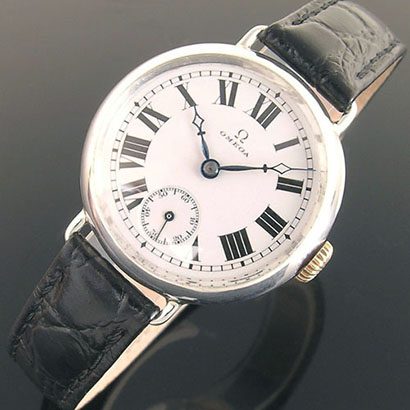THE HISTORY OF THE
PATEK PHILIPPE CALATRAVA
The Patek Philippe Calatrava has come to epitomise what a dress watch should be. Simple, slim, and elegant. So strong is this identity that collectors often refer to simple time-only dress watches from other brands as Calatravas. As we explore the history of the Patek Philippe Calatrava, we will discover that they are not always simple and not always slim and dressy.

The source of the name
Calatrava is the name of a castle in the Castille region of Spain and a religious order of knights formed in 1157 to defend it. The Calatrava Cross is the emblem of the Order of the Knights of Calatrava and consists of a red Greek cross with a fleur-de-lis at the ends.
In 1887, Patek Philippe chose this symbol to register as a trademark along with the name Patek Philippe & Cie. The reason for this choice is unclear, but whether it was just an attractive and distinctive pattern or if some deeper connection is implied, the Calatrava was rarely seen on the brand’s early watches and was not used as a model name until the 1980s. Despite this, the term Calatrava has been retrospectively applied to Patek Philippe’s simple time-only watches from the 1930s beginning with Reference 96.

A new beginning
The end of the 1920s saw Patek Philippe in severe financial trouble. Despite creating groundbreaking wristwatches such as a five-minute repeater ladies’ watch, a split-second chronograph, and a perpetual calendar, the Great Depression had taken its toll, and the company needed investment.
Salvation came in 1932 from the Stern Brothers, Henri and Jean, the owners of Patek Philippe’s dial suppliers. They hired Jean Pfister, who had previously run the hugely successful Tavannes watch company. Amid this upheaval, the Ref. 96 was born. Not yet a Calatrava, but the start of what would become one.
Before this point, Patek Philippe listed all their watches individually by case number. The Sterns used Ref. 96 to install some organisation and rigour to the company’s output, introducing the concept of a model number.

The Calatrava Reference 96
The Ref. 96 was not, as many online sources suggest, designed by David Penney in 1932, as the British illustrator would not be born for almost twenty years. This fallacy came about as David Penney’s name was found on his illustrations of Ref 96 and incorrect assumptions were made. The watch’s design is cited as a classic example of Bauhaus, with its simple lines and ‘form following function’. This is only part of the story.
True Bauhaus celebrated high-end craftsmanship hidden behind a seemingly simple exterior. In this spirit, the Ref. 96 disdains a simple pad-print dial in favour of a diamond-engraved design back-filled with black lacquer before being kiln fired. The appearance is the same, but the print can never wear off. The elegant and comfortable down-turned case lugs are cast as part of the case design rather than being soldered on afterwards.
Early movements for the Ref. 96 came from LeCoultre, Patek Philippe’s long-term supplier. In 1934, Patek Philippe created their first in-house wristwatch movement, the calibre 120, specifically for the Ref. 96.

Simple but varied
Over its 41-year history, Ref. 96 offered several variants of its time-only form, including case material, dial layout, and decoration. As with its modern output, steel is far less common than precious metals, so creating only 95 examples of Ref. 96 was a significant development that excites modern collectors.
Examples included scientific ‘sector dial’ versions, including the first-ever steel Ref. 96, and military-inspired watches with luminous Arabic numerals and syringe hands. These were interspersed with the more usual baton dials or Breguet numerals. Unusual precious metal variants include platinum-cased watches with diamond-set dials and a yellow-gold example with a ‘telephone’ dial – the dial markers being large round blobs of luminous material. Rare examples of Ref. 96 moved the seconds sub-dial to the 9 o’clock position, incorporated an addition to the movement to allow a central seconds hand, or deleted the seconds.

Complications
While Ref. 96 is lauded for its simplicity, complicated versions exist. The highest number of functions crammed into the tiny 30mm diameter case is five, including the seconds sub-dial, date, day of the week, month, and moon phase indication. In 2023, Phillips Auctioneers sold an example of this watch previously owned by Aisin-Gioro Puyi, the Last Emperor of the Qing Dynasty, for almost £5 million. Even rarer is the Ref. 96 ‘Heure Universelle’, a world-time watch created in 1937 that featured the 24 global time zones, each indicated by a city name, around the edge of the dial.

What is a Calatrava?
If the name ‘Calatrava’ wouldn’t be applied officially until the 1980s, at which point the watch would be whatever Patek Philippe chose it to be. What do experts believe are the identifying features of an older Calatrava? Three details stand out: a slim, round case, a flat bezel, and simple, flat, down-turned lugs integrated into the case. Using these guidelines, we can trace the evolution of the Calatrava over the years:
Ref. 570 – Released in 1938, this followed the same lines as Ref. 96 but on a larger scale with a 35.5mm case.
Ref. 565 – Offered with either a small seconds dial or central seconds, this was the first water-resistant Calatrava featuring a screw-down case back. A more practical watch, it appeared in steel far more often than Ref. 96.
Ref. 2457 – Produced from 1949 to 1958 to replace Ref. 96, this lesser-known reference followed the same diameter and proportions as the original watch and was ultimately outlasted by it.
Ref. 2526 – This watch divides collectors as to its inclusion in the Calatrava list. Some point to the simplicity of the dial design and the slim, round case; others argue that the rounded bezel and different lug design exclude this reference. Either way, it is one of the first self-winding Patek Philippe watches and an important watch with Calatrava-like features.
Ref. 3520 – Arguably, this watch represents the archetype for modern iterations of the Calatrava. It differed from Ref. 96 in several ways. The case diameter may only have been a millimetre or two wider, but the lugs were slimmer and straighter. Narrow batons replaced the typical Ref. 96 dauphine hands. Most noticeably, the bezel featured a hobnail or ‘clou-de-Paris’ design that has endured on Calatrava watches to the present day.
Ref. 3960 – The 150th anniversary of the Patek Philippe company in 1989 was an excuse to celebrate, and the Calatrava produced to mark the occasion showed a novel exuberance. A hinged case back was added to allow the owner to view the movement via a sapphire crystal window. Screw bars replaced spring bars on the lugs, and the crown took a more bulbous ‘onion’ form.
Ref. 5000 – The 1990s saw a nod back to the whimsical dials of Ref. 96 with the launch of Ref. 5000. A diminutive 33mm by contemporary standards, although radial Arabic numerals added a more modern aesthetic. The seconds sub-dial was moved to the 4.30 position, a feature echoed in the 2017 Ref. 6006, which added a pointer date.
Ref. 5117 – As the 21st Century arrived, the Calatrava took on its most sporty form so far, hinting at what would come in the contemporary collections. The case diameter had increased to a more modern 37mm, the seconds were a central sweep hand, and a date indication window sat at 3 o’clock. Most unusually, guards appeared on the case to protect the screw-down crown, giving this classic dress watch a more utilitarian appearance.
The Calatrava today
The current Patek Calatrava collection covers 13 simple models and six complications. The concept of the Calatrava has been stretched to encompass 42mm two time-zone chronographs and annual calendars in the form of Refs—5924 and 5326, respectively, as well as the simpler time-only models.
Ref 5088/100P celebrates the decorative arts, the two hands sitting above a dial engraved with volutes and arabesques against a deep black enamel background. There are elements of the original Ref. 96 still discernible; the flat bezel and downturned lugs making an appearance across most of the collection. However, in the 2020s, Patek Philippe sees the Calatrava as anything round, not too sporty, and not a grand complication: an enormous change from such simple beginnings.
For a wide range of Patek Philippe Calatrava models spanning 70 years of manufacture, and offered with a lifetime authenticity guarantee, head to Vintage Gold Watches. We specialise in vintage Patek Philippe and have a large collection of many Patek models. If you can’t find what you’re looking for, get in touch and we will be happy to explore the market on your behalf.
For the latest vintage watch news, and to be the first to see our new stock as it arrives, sign up to our weekly newsletter.




